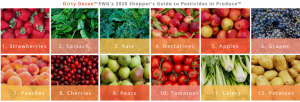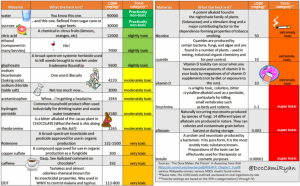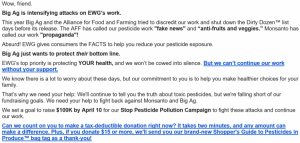The Environmental Working Group’s annual “Dirty Dozen” list misleadingly stokes the public’s fears of eating fruits and vegetables
A uniquely frightening time like this provides a great moment for us all to do what’s best for neighbors, employees, customers — the greater good. Conflicting with this sentiment, the Environmental Working Group’s annual “Dirty Dozen” list stokes our fears of eating fruits and vegetables with pesticide residues. But is EWG right? Or do the benefits of eating produce far outweigh these concerns?
Full disclosure: I buy organic fruits and veggies. I also buy conventional fruits and veggies. For me, it depends on the time of year, the way the produce looks, which grocer or market I’m visiting, and price (those two-for-one berry deals are no joke!). At Dirt-to-Dinner, we also believe that feeding a growing population requires all kinds of safe, sustainable growing methods. We should have a choice and not be unnecessarily fearful of the food at the grocery store.
What’s at stake?
If I told you that I only buy organic produce, you’d probably assume that I had the EWG’s list of contaminated produce memorized for when I go shopping, right? And probably expound on the “horrors” of conventional farming, too. Some of you may not know what EWG is, but you’re probably familiar with their annual “Dirty Dozen” list showing which conventionally farmed fruits and veggies have the most pesticide residue based on data from the USDA Pesticide Data Program. But should you really be afraid of these “Dirty Dozen” items?
EWG would give a big “yes” to that one. But wouldn’t you do this, too, if your corporate donations came from Organic Valley, Earthbound Farms, Applegate Farms, and Stonyfield Farms? Hey, I kinda get it — they’d infuriate their stakeholders if they published information discouraging their products. But their report hurts our health and frankly, our sanity. And at a time when we need it most with COVID-19.

Sad state of health
Did you know that only 10 percent of us eat the recommended amounts of fruits and veggies each day? I’m literally sneaking riced cauliflower and diced sweet potatoes into my oatmeal each morning and am barely scraping by in that department. There is no doubt about it: washing, chopping, and preparing five to nine servings of veggies for each family member every day takes a lot of time.
But what about those who can’t even shop for fresh produce? The USDA’s food desert map examines lower-income and lower-access locations where people live far from a supermarket. EWG’s message particularly preys on these shoppers. In a peer-reviewed study in the journal, Nutrition Today, researchers found that low-income participants preferred not to buy produce at all — neither organic nor conventional — when informed of specific fruits and veggies with pesticides, putting this group at greater risk of obesity, heart disease, and cancer. Kinda counter-productive to EWG’s mission, right?
“Messages naming specific fruits and vegetables with pesticides shifted [low-income shopper] participants toward ‘less likely’ to purchase any type of FV, regardless whether organically or conventionally grown.” — Burton-Freeman et al., Nutrition Today
You’re only as good as your data
Though we’ve previously posted on how the USDA and EPA monitor and manage pesticide residues on produce, here are a few points about the margin of safety the EPA applies to our produce, the data gathered by the USDA that shows where produce falls within that spectrum, and how the EWG misrepresents the data to scare the daylights out of us.
Let’s first take a look at data collection and what it shows:
Organic and conventional crops: It’s not a level playing field
- First off, organic farms can and do use pesticides. Look it up here.
- The EPA oversees testing for synthetic pesticide toxicity before being approved for use. However, organic pesticides are not required to be tested for toxicity; only guidance is provided.
“The EPA requires synthetic pesticide manufacturers to conduct a whole battery of tests for initial and ongoing registration. The extensive and costly testing is conducted to determine toxicity on human health from dermal exposure, inhalation, and ingestion, and assesses human health outcomes related to reproduction, cancer, and organ systems.
“On the other hand, ‘natural’ organic pesticides are not required to be tested for toxicity and have never received this level of assessment.” — Susan Leaman, Toxicology Consultant, Vice President at IDS Decision Sciences
- Have you heard of copper sulfate? It’s considered an organic pesticide and is frequently used on crops prone to fungus. It’s also one of the most toxic pesticides. Yes, even among synthetic ones.
Toxicity Levels of Various Substances

Yes, there is pesticide residue on most produce — both conventional and organic. It’s also in our air. And water. And, our bodies can handle it. Time to move on.
- Despite what you may hear on the interwebs, the USDA conducts very rigorous testing on thousands of produce samples for its Pesticide Data Program (EWG’s data source). The USDA then works with the EPA to develop tolerances for acceptable pesticide residue on produce.
- This is how the EPA determines pesticide tolerance: they identify an allowable level of residue for no health risks based on exhaustive toxicological evaluations. If a residue is at or below the tolerated amount, it is safe by a factor of 100, which means the residue present is 100 times smaller than the smallest amount that would have a negative health effect. That’s a pretty plentiful safety cushion there.
“In reality, exposure to toxins like pesticides is not as simple as ‘this is good, that is bad’. Whether or not something is toxic depends on numerous factors, such as the substance’s form, the amount you are exposed to, how you are exposed, and your genetic make-up.” — Susan Leaman, Toxicology Consultant, Vice President at IDS Decision Sciences
- Still scared? Check out this page from Alliance for Food and Farming, which represents organic and conventional produce farmers, to see how much produce you’d need to eat to incur some ill effect from the residue, based on our gender and age range. As much as I love strawberries, I don’t think I can eat 453 berries in one day ?
EWG’s dirty data habits
Look, we don’t need to go too far down this rabbit hole of EWG’s dubious research practices. Thankfully, plenty of researchers with lots of peer-reviewed studies to factually substantiate their claims have made a more compelling argument than I can to discredit EWG’s improper research methods and false claims.
But let’s take a quick look at how EWG takes advantage of omissions and manipulates data in favor of their stakeholders:
EWG’s desperate search for data to substantiate their position
EWG gets its report by citing all known detections of pesticide residue on produce samples in the USDA’s report — no matter how insignificant. And that’s how they scare us. But what they don’t disclose is that these residues are also found on organic samples, too. Even synthetic pesticide residues are found on organic produce …
EWG recycles practically all the same data as previous years and slaps the “2020” on Food Shoppers Guide to make it look meaningful
- The USDA analyzes pesticide residues with dozens of rotating crops, so each year only select crops are re-analyzed. For instance, this year it was just three crops analyzed that fall under EWG’s coverage: asparagus, cabbages, and sweet peas. Yet they make a big stink about releasing a whole new report, instead of just giving an update on the 6% of data that may or may not have changed since last year!
- To that end, we don’t know the current pesticide levels of pineapples and eggplants, which were last analyzed in 2002 and 2006, respectively. But both show up on EWG’s “Clean Fifteen” list, without really knowing levels within the last 14+ years.
- As for raspberries, another delicately-skinned fruit like strawberries (notoriously #1 in the “Dirty Dozen”), they haven’t been analyzed since 2013 – a long time for those overly-concerned with these things.
And EWG only addresses COVID-19 …
- In a recent email touting their “COVID Tips,” EWG states that “organic vegetables … offer a great nutritional bang for your buck.” Ummmm … I’m pretty sure conventional produce is still the cheaper option. Also, nutrient density depends on the health of the soil, not whether it’s organic.
- Even worse, EWG’s email also states “to reduce the risk of ingesting pesticides, wash all conventional produce by running it under the faucet”. Yeeesh … where were they on this one? We must wash ALL our produce. Pathogens like e. coli and salmonella don’t care if it’s organic or conventional … so always wash up!
… When it’s convenient for them
- Suddenly they’re reporting on shelf-stable goods? Their report vilifies conventional raisins during a time when some of us don’t have access to fresh fruit. What kind of timing is that?
- And as unemployment skyrockets, they send an email blast asking for money ☹ Sounds kinda culty, too, right? And, I don’t know, maybe directing at least SOME of those funds to a COVID relief fund would make this email seem a little less crude and more helpful at keeping people alive and healthy, perhaps?

EWG actually knows better
The most disheartening part about the EWG’s Dirty Dozen report? They know they’re causing unnecessary panic. Perhaps in light of the current pandemic, they stated in their press release that “… consumers should continue eating plenty of healthy fruits and vegetables, whether they are conventional or organic.” Doesn’t this seem contradictory to their entire report? So why cause more panic when we’re all already freaking out???
There’s no question that the benefits of eating fresh fruits and vegetables FAR outweigh any ill effects from pesticides — the vitamins, minerals, antioxidants, fiber, and other nutrients keep our bodies healthy. How else are we to build up our immune systems to help combat this virus?
Uniting for health
Despite the mixed messages of the EWG report, there’s one common theme that unifies us all in our plight for overall and immune health: to eat more fruits and veggies, no matter the source. Whether explicitly said by nutritionists and doctors, or hidden between the lines in a press release, we all agree that eating more produce can positively affect our immunity against COVID, and beyond.
And if you are still concerned about pesticide residues and pathogens, just rigorously wash and prepare your produce.
“Make sure to wash your produce thoroughly under cool running water BEFORE eating or preparing. It is important to rinse…to avoid transferring dirt or bacteria onto your knife, the flesh of the produce or your work surface. The FDA does not recommend washing your fruits and vegetables with soap…however, you may want to use a clean produce brush to scrub firm crops.”
– Maki Yazawa, RealSimple
My last point is for those who are still skeptical …
If you question the USDA and EPA data, just remember that between two stories may lie the truth. So, if you recall that the EPA’s pesticide residue tolerance scale for produce must be “100” at a bare minimum, and “1” is a serving of produce that has enough pesticide residue to cause an immediate ill health effect (as the EWG would like us to believe), that halfway point brings us to “50”. Even at a factor of 50, I would still encourage my family and friends to eat lots and lots of produce. Even then, 226 strawberries are still too many for me to eat at once ?
The bottom line
The EWG report negatively affects our shopping decisions with baseless information that preys on our fears. During these times, it’s even more important to make rational decisions about our health to protect ourselves and others by fortifying our immune systems. So when I see those strawberry packages that are on sale for “buy 2 get 1 free”, you better believe I’m stocking up, no matter how it’s farmed.



